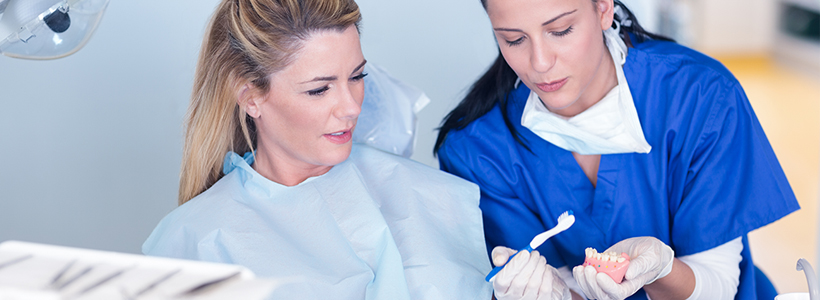DENTAL PROPHYLAXIS BORDEAUX

Prophylaxis is defined as "all the means put in place to prevent the appearance of a disease". It prevents the development of cavities and loosening and aims to preserve the results of dental care.
Decay, loosening, and the loss of teeth that can result from this are not inevitable. If today, the clinical examination of your mouth reveals a satisfactory state and that your oral state does not present any symptoms met commonly in dentistry, this state of health remains precarious. The statistics are explicit: only 5% of the population will not encounter a tooth disease.
In our dental office all the means are implemented to prevent the appearance of the cavity or periodontal disease (loosening) and to check the evolution and the aggravations. As a result, a prophylactic follow-up program is offered to you to avoid the appearance and development of oral bacterial diseases. Prophylactic care is a substitute for traditional scaling, the results of which are largely insufficient to prevent loosening nand to protect against cavities.
Decay, loosening, and the loss of teeth that can result from this are not inevitable. If today, the clinical examination of your mouth reveals a satisfactory state and that your oral state does not present any symptoms met commonly in dentistry, this state of health remains precarious. The statistics are explicit: only 5% of the population will not encounter a tooth disease.
In our dental office all the means are implemented to prevent the appearance of the cavity or periodontal disease (loosening) and to check the evolution and the aggravations. As a result, a prophylactic follow-up program is offered to you to avoid the appearance and development of oral bacterial diseases. Prophylactic care is a substitute for traditional scaling, the results of which are largely insufficient to prevent loosening nand to protect against cavities.
The carious disease
Cavity is an infectious disease caused by microbes in the mouth. Dietary deposits and sugars promote the proliferation of cariogenic bacteria harmful to oral health. Causes of the disease: Your mouth contains, and it is normal, very many microbes. Some are "friendly" and others are "hostile". Of these, there are some that cause cavities. When these two categories balance, you are in good dental health and you do not develop cavities. Under certain conditions, hostile microbes can accumulate in your mouth, feed on the sugars in your diet, and produce acids. It is these acids that "cariate" the teeth.
Evolution
This disease does not develop on a regular basis; it evolves over several months in cycles more or less fast depending on the subjects. There is a gap between the appearance of the first clinical signs of caries and the previous acquisition of the various responsible factors. This disease can cause :
stains, holes
sensitivities to cold, hot, sweet or sour foods
pains
nerve damage, "toothache"
abscesses
tooth loss
distant infections to the heart, or other organ, to a prosthesis of the hip, knee of the breast ...
Aggravating factors
sickness or drugs that disrupt your saliva
ineffective dental follow-up, lack of fluoride
adverse environment, past carious
unsuitable dental care
grooves or dental form weakening your teeth
loosening, misplaced teeth, prostheses
orthodontic treatment
Inadequate plate control where you do not brush
high rate of microbes responsible for caries
low saliva production
saliva poorly regulate oral acidity
repetitive sweet food
professional activity
general state of health
The early stages of caries are visible only through specialized examination in the office, they are also sometimes reversible. The hole is only an advanced and irreversible form of the disease. It is common that this hole is reduced or invisible on the surface and very important inside. Decay affects the "living" tooth or not. When devitalized, there is no painful sign. It also happens on a living tooth decay is painless.
Prevention
Decay is one of the two most common infections in humans. We have today, for you, ways to stop it, to restore the damage it has caused, to ensure the duration of the restoration and to avoid the recurrence of this disease. The first stages of caries are reversible thanks to medicinal treatments in local application: they are the prophylactic treatments on the surface.



